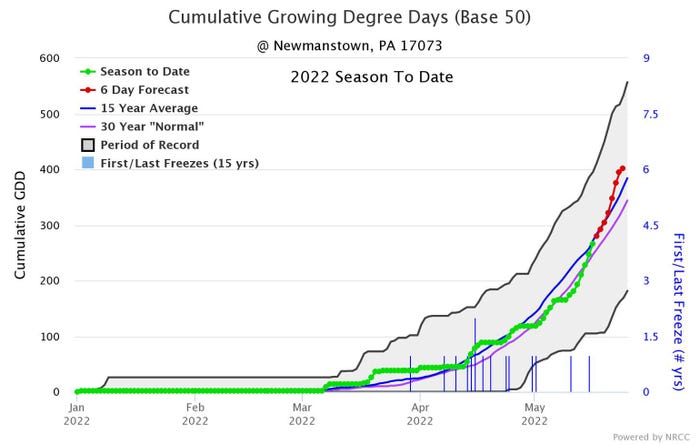
Most of the region got a taste of summer this past weekend. With all the rain that’s fallen as of late, it was a welcome reprieve — and a chance for growers to get caught up with planting.
“I think we are pretty well on schedule,” says Trey Hill, owner of Harborview Farms in Rock Hall, Md., where he farms 10,000 acres of corn, wheat, double-crop and full-season soybeans. “Last 20% is taking what feels like forever to get in, but I don’t really feel late yet. We won’t make any changes for another week or two. Looks like some good, hot weather on the way to get things wrapped up.”
The most recent Crop Progress Report from the National Agricultural Statistics Service showed 32% of corn planted in Maryland, well behind the five-year average of 59%. But growers likely made up for it this past weekend as things finally dried out.
Soybeans are 28% planted, ahead of the 20% five-year average.
Next door in Delaware, 52% of corn is planted, and 29% of the crop has emerged — both slightly behind the five-year averages. Only 12% of the state’s soybean crop has been planted.
Eric Rosenbaum, owner of Rosetree Consulting, a crop consulting firm out of Shillington, Pa., wrote this in an email last week when asked about planting progress in eastern Pennsylvania:
“Looking back at my Google photos for mid-May 2021, here's a comparison: May 16, 2021, we were looking at soybean fields where the first trifoliate was emerging (3-4 inches tall). Today, May 16, 2022, we are looking at soybeans that are barely out of the ground. Same with corn, early-planted corn in 2021 was 12 inches tall by this time, while 2022 early-planted corn is 3 inches tall. We are about 14-20 days behind in planting and growth compared to last year.”
But growers in the state appeared to have made some progress with 33% of corn planted and 10% of soybeans now in the ground, both around average for this time of year. As most growers know, many other factors affect plant growth and, ultimately, yield.
“I need to keep reminding myself that planting date is only one factor in yield,” Rosenbaum says, “and that the planting date relationship to yield is related to the overall year we have, not just the conditions in April. Drought and excessive heat during pollination, or prolonged cloudy weather during grain fill, may impact yield more than a later planting date.”
Dave DeGolyer, executive consultant with Western New York Crop Management Association, which consults on more than 500,000 acres in New York and Pennsylvania, says planting conditions improved enough for most growers to get caught up after a cold, rainy late April.
Corn is 34% planted in the Empire State, which is ahead of the 14% five-year pace for this time of year. Soybeans are 27% planted, well ahead of the 5% average. DeGolyer says more growers are planting soybeans before corn, as beans will tolerate cooler conditions better.
“A lot of people have moved in that direction,” he says.
Another thing that DeGolyer has noticed is a lot fewer winter grains growing this spring. He estimates at least 50% less acreage in winter wheat and barley, largely because last fall’s cold and rainy conditions made it too hard for growers to get a winter crop in the ground. Most of the ground that wasn’t planted likely went to either corn or soybeans, or even a spring-planted forage.
Buckeye State growers have gotten 31% of corn and 18% of soybeans planted, both slightly behind their five-year averages. Wheat is also behind with only 6% of the crop heading, trailing the five-year average of 19%.
Michigan growers have gotten 31% of corn planted, behind the five-year pace of 41% planted. Soybean plantings are slightly better with 32% percent of acres planted, which is about average for this time of year.
Growing degree days
It’s a good idea to keep track of growing degree days, as this is a good indicator of whether your crop will reach its yield potential.
The average growing degree days needed for corn, for example, ranges from 1,600 to 3,175 depending on relative maturity of the variety you planted. Corn accumulates growing degree days in the temperature range of 50-86 degrees F.
Cornell’s Climate Smart Farming Growing Degree Day Accumulator is a handy tool that can show you the number of growing degree days accumulated by location. Here’s a chart showing current accumulated growing degree days in Newmanstown, Pa., for this season:

Growing degree days are calculated by taking the mean (average) of the daily maximum temperature and minimum temperature, and then subtracting a base temperature. Corn, for example, has a base temperature of 50 degrees, the lowest temperature the crop will grow. Alfalfa, which is cold-hardy, has a base temperature of 41 degrees.
Here is a handy example for calculating growing degree days for corn on a given day from Penn State Extension:
Record the high temperature: 80 degrees.
Record the low temperature: 60 degrees.
Corn base temperature: 50 degrees.
Calculate mean (average) temperature: 80 degrees + 60 degrees divided by 2 = 70 degrees.
Now, calculate growing degree days: Take 70 degrees (average) minus 50 and you get 20, the amount of growing degree days for that given day.
About the Author(s)
You May Also Like






